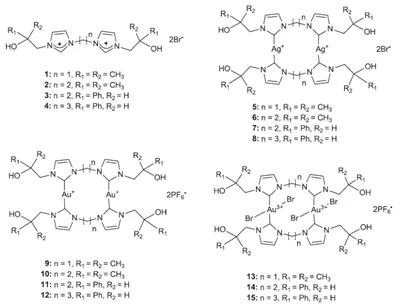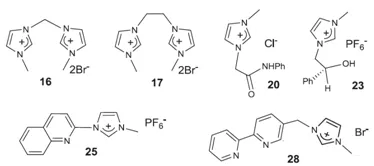This is an abstract for a paper chosen to present a seminar in the Simón Bolívar University:
Synthesis, structures, and antimalarial activities of some silver(I), gold(I) and gold(III) complexes involving N-heterocyclic carbene ligands
Hemmert Catherine, Fabié Aymeric, Fabre Aude, Benoit-Vical Franςóise, Gornitzka Heiz
European Journal of Medicinal Chemistry 60 (2013) 64-75
Metal-NHC complexes (NHC, N-heterocyclic carbene), are species widely studied due to the chemical and structural versatility offered by the NHC. One of the types of metal-NHC complexes evaluated in the area of medicinal chemistry are the silver (I) compounds [Ag(I)-NHC], these were the first to show various types of biological activities, such as antimicrobial and anticancer activity. However, its main application in this area to act as NHC transfer agents. This has allowed expanding the synthetic possibilities and the study of metal-NHC complexes with various metal centers. Among them, the gold (I) and gold (III) complexes which have shown anticarcinogenic, antiarthritic, and antimicrobial activity. Malaria is still the parasitic disease with the biggest impact in the world and the Plasmodium parasite, has shown strong resistance to chloroquine. Because of this, Hemmert et.al. sought to synthesize new metal-NHC complexes which might present antimalarial activity against those strains resistant to chloroquine, as well as to evaluate their possible antifungal activity.
The authors propose to study the possible antifungal and antimalarial activity of 15 compounds previously reported by Hemmert et al. The authors report the synthesis and characterization of a second series of mono and dinuclear silver (I) and gold (I) carbenic complexes, obtained from bis(imidazolium) salts, also synthesized and reported by their work (fig.1). With this series of complexes, the authors propose to evaluate the structure-activity relationships of the new ligands. Specifically, how these structural changes can affect the antimalarial activity of them.

Fig.1 First series of dinuclear complexes

Fig. 2 Carbene precursors of the second series of complexes
By evaluating the antimalarial and antifungal activity of the first series of compounds (figure 1), the best results corresponded to the silver (I) dinuclear complexes (5-8) for both cases. They showed lower IC50 levels and MIC for Candidemia, however, all had hemolytic properties. Subsequently, the evaluation of the second series of mono and dinuclear complexes of gold (I) and silver (I) was carried out, which showed, in their majority, antiplasmodic (antimalarial) properties. Highlighting the complexes of the type Au(I)-bis(NHC) which mostly showed IC50 values lower than the complexes of the first series (fig.1), it was also possible to eliminate the hemolytic properties in all the synthesized complexes.